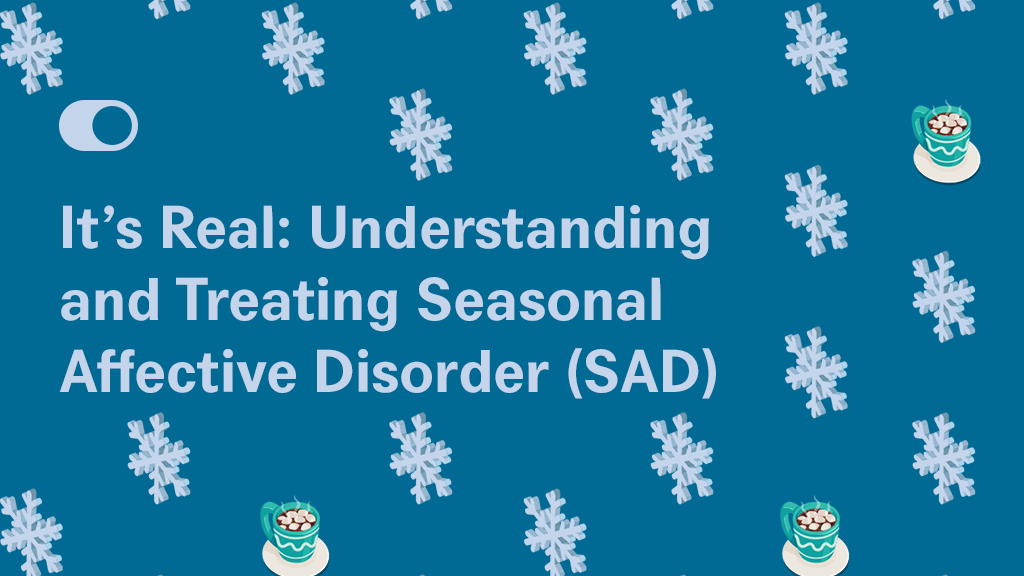Sweater weather’s in full swing. It’s dark outside long before dinnertime. And you feel tired, slow, and, yes, a bit glum. Guess what? Totally normal. For some, though, the lack of daylight and change in temperature (and clothing) trigger more than just mild, temporary dips in mood, aka “winter blues.”
Seasonal Affective Disorder (SAD) is a diagnosable condition related to changes in seasons, which sits under the umbrella of depression. (In fact, it’s often referred to as winter depression.) At Crossover, we’ve seen how SAD can impact mental health, productivity, and quality of life. Below, we’ll explore how SAD differs from general depression along with effective SAD treatment strategies and tips for managing seasonal mood changes.

The Basics of SAD
What Is SAD?
SAD is a subtype of depression, characterized by a recurring and predictable seasonal pattern of symptoms, such as fatigue, sadness, and lack of motivation. It most often occurs during darker, colder months and abates as spring and summer return. Functioning with SAD is challenging and can be overwhelming, impacting all aspects of work, home, and family life.
Who Gets SAD?
Bottom line: Anyone can get SAD at any time of year. However, those living far north of the equator with a more dramatic reduction of sunlight in the winter (think Northeast, Midwest, Alaska) have an increased risk. People with bipolar disorder, and a family history of SAD are also at higher risk. SAD typically begins during adulthood, and affects more women than men.
What Causes SAD?
While definitive causes remain unknown, leading theories revolve around the effects of reduced sunlight during autumn and winter months: disruption of melatonin (a hormone that regulates sleep), circadian rhythm (the body’s internal clock), and serotonin (a neurotransmitter that influences mood). A combination of genetic and environmental factors may also contribute to onset of the disorder.
SAD Diagnosis, Symptoms, and How It Differs From Depression
From persistent sadness and feelings of hopelessness to loss of interest in favorite activities, SAD shares many symptoms with general depression and is just as serious. The primary differentiator? SAD’s predictable and recurring pattern with symptoms shifting seasonally—typically getting worse and more intense in the winter months when daylight is at its scarcest.
Diagnosing SAD
For a diagnosis to be made, a depressive episode must happen at the same time of year for at least two consecutive years, with periods of non-depressed mood in the remaining seasons (usually spring and summer).
Additionally, before confirming a SAD diagnosis, symptoms related to situational or external factors—such as general stress or family-related grief or tension related to the holiday season—must be ruled out.
Winter Depression Symptoms
Undoubtedly, everyone’s experience is unique. But there are common core SAD symptoms that occur with varying degrees of intensity as seasons shift including:
- Persistent low mood, sadness, or hopelessness
- Losing interest or pleasure in previously enjoyed activities
- Fatigue, low energy, and sluggishness
- Trouble concentrating or “brain fog”
- Feelings of worthlessness or guilt
- Changes in sleep and challenges getting out of bed (often oversleeping)
- Appetite changes, especially carbohydrate cravings and weight gain
- Feeling agitated or irritable
- Social withdrawal, a desire to isolate and hibernate
- Thoughts of suicide or no longer wanting to live—this can be passive or active
Effective SAD Treatment Strategies and When to Seek Support
One positive thing about SAD: it tends to be highly responsive to treatment.
Treatment Strategies
First things first, get outside! Soak up and maximize time in natural light. This isn’t always possible, which is where light therapy for seasonal depression comes in. It’s often the first treatment recommended—especially for those with classic winter-pattern SAD. Using a specialized light box (easily purchased online) to get simulated sun every day for $15$ to $30$ minutes can really help ease symptoms.
Another strategy many Crossover Mental Health providers share with SAD patients is called opposite action. Essentially, it’s a behavioral technique meant to counteract the urge to withdraw and isolate. You reflect on a situation to determine if there’s a legitimate reason you don’t want to leave the house, exercise, socialize—or if it’s just the SAD talking. “If it’s SAD, you tell yourself ’I should probably go outside, and it will probably be good for me,’” explains Dr. Nicole Thalheimer, a licensed clinical psychologist. “It can be for five minutes and that can make a difference.”
Indeed, talk therapy has been shown to be particularly effective for SAD. It can help identify thought patterns and behaviors that may worsen seasonal mood changes, while building coping strategies that promote resilience year-round. Seeking help early can make a meaningful difference in managing SAD and supporting one’s overall emotional well-being.
In some cases, antidepressant medications may be prescribed to help rebalance brain chemistry. These drugs have been known to benefit those with severe SAD or when light therapy is ineffective. Your Mental Health provider can work with you to determine whether this is an appropriate option.
When to Seek Mental Health Support
So how do you know when it’s time to get professional help?
- When symptoms start interfering with your day-to-day functioning (getting out of bed, preparing meals, etc.)
- Experiencing difficulty with regular routines and keeping up with responsibilities
- Favorite activities no longer bring joy, relief, or boost mood—think running, playing with pets, socializing
- Trust your gut: If you’re wondering if now’s the time to get help, it probably is
Managing Seasonal Mood Changes: Daily Habits

Employing practical, daily habits can significantly improve symptoms. Working any of these behaviors into your life are likely to help. Keep in mind, doing anything is better than nothing. Baby steps will eventually get you there.
- Schedule and participate in meaningful activities, social connections, and structured tasks
- Find joy and gratitude with your kids, pets, loved ones, and in nature
- Keep blinds open and sit near windows while working, and get outside for a walk even on cloudy days
- Maintain a regular sleep and wake schedule throughout winter to help stabilize circadian rhythm
- Move your body every day—regular physical activity can boost mood and reduce anxiety.
- Eat healthy balanced meals to help fight carb cravings, which can lead to a short-term energy spike followed by a crash
- Keep a mood/energy journal to monitor symptoms over time and detect shifts early
No doubt, SAD can be a serious condition. But with awareness, lifestyle adjustments, and the right treatment, it can be effectively managed. If you notice ongoing changes in your mood or energy this season, talk with your Crossover team to develop a plan to support both your mental health and overall well-being…so you can move through fall, winter, spring, and summer with balance, energy, and light.
Have questions?
Make an appointment with your Primary Care provider to address your needs and/or connect with a Mental Health provider if you need support.
About the Reviewers

Dr. Michael Boroff, PsyD | Crossover Health Sr. Program Manager, Mental Health
Michael oversees the organization’s mental health services nationwide while also seeing members within Crossover’s integrated, team-based care model. He has spent his years at Crossover establishing, implementing, and maintaining a mental health model of care based on approaches that are progressive, sustainable, and scalable. He oversees the mental health program culture and communication, has large responsibility for hiring and onboarding new team members, in addition to providing direct clinical services where he specializes in helping members with ADHD, OCD, work stress, relationship concerns, depression, and anxiety.

Dr. Nicole Thalheimer, PsyD | Crossover Health Psychologist
Dr. Nicole “Nikki” Thalheimer is a licensed clinical psychologist on Crossover’s Virtual Care Team. A generalist by training, her expertise and lifelong passion center on gender diversity, and sexual orientation. With over a decade of experience supporting individuals, couples, and families, Dr. Thalheimer now serves as one of Crossover’s gender specialists, providing affirming care for trans and nonbinary clients alongside treating depression, anxiety, and related concerns.
